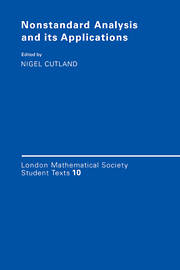Book contents
- Frontmatter
- Contents
- Preface
- Contributors
- AN INVITATION TO NONSTANDARD ANALYSIS
- INFINITESIMALS IN PROBABILITY THEORY
- INFINITESIMALS IN FUNCTIONAL ANALYSIS
- APPLICATIONS OF NONSTANDARD ANALYSIS IN MATHEMATICAL PHYSICS
- A LATTICE FORMULATION OF REAL AND VECTOR VALUED INTEGRALS
- AN APPLICATION OF NONSTANDARD METHODS TO COMPUTATIONAL GROUP THEORY
- SYNTACTICAL METHODS IN INFINITESIMAL ANALYSIS
- SOME ASYMPTOTIC RESULTS IN ORDINARY DIFFERENTIAL EQUATIONS
- SUPERINFINITESINALS AND INDUCTIVE LIMITS
- THE NON-LINEAR BOLTZMANN EQUATION FAR FROM EQUILIBRIUM
- INDEX
SUPERINFINITESINALS AND INDUCTIVE LIMITS
Published online by Cambridge University Press: 05 June 2012
- Frontmatter
- Contents
- Preface
- Contributors
- AN INVITATION TO NONSTANDARD ANALYSIS
- INFINITESIMALS IN PROBABILITY THEORY
- INFINITESIMALS IN FUNCTIONAL ANALYSIS
- APPLICATIONS OF NONSTANDARD ANALYSIS IN MATHEMATICAL PHYSICS
- A LATTICE FORMULATION OF REAL AND VECTOR VALUED INTEGRALS
- AN APPLICATION OF NONSTANDARD METHODS TO COMPUTATIONAL GROUP THEORY
- SYNTACTICAL METHODS IN INFINITESIMAL ANALYSIS
- SOME ASYMPTOTIC RESULTS IN ORDINARY DIFFERENTIAL EQUATIONS
- SUPERINFINITESINALS AND INDUCTIVE LIMITS
- THE NON-LINEAR BOLTZMANN EQUATION FAR FROM EQUILIBRIUM
- INDEX
Summary
Introduction. This article shows how to apply the ideas of Benninghofen & Richter (1985) to study two kinds of topological inductive limits whose monads do not usually have simple descriptions. The monads of these topologies do contain an easily computed core which we call the limit infinitesimals. Benninghofen and Richter's theory of product monads allows us to show that computations with limit infinitesimals extend to the full monad and consequently imply various new standard topological results.
The results of this paper are a summary of joint work with B. Benninghofen and M.M. Richter that will appear elsewhere in greater detail. We thank N. Cutland for his advice and for allowing us to publish his π-Transfer Theorem 2.3.
We shall work in Lindstrøm's polysaturated nonstandard model V(*S). We also need some of the syntactical ideas from the article of Diener & Stroyan in this volume. We shall use the notation and Syntactical Theorem on Monads from that article.
MONADS
If U is an entity of V(S), the set of standard elements of U is denoted σU = {U ∈ *U : st(U)} = {*V : V ∈ U}.
Definition
A nonempty set µ ∈ V(*S) is called a monad if and only if there is a standard family U of subsets of a standard set W such that
The monad µ ⊇ *W is nonempty if and only if the corresponding standard family tU is a filter base on W.
- Type
- Chapter
- Information
- Nonstandard Analysis and its Applications , pp. 298 - 320Publisher: Cambridge University PressPrint publication year: 1988
- 1
- Cited by



